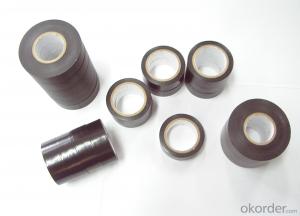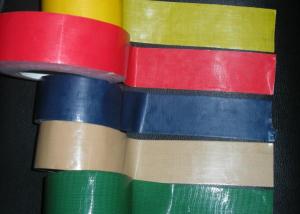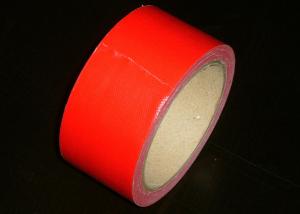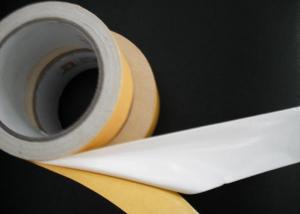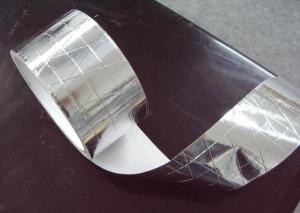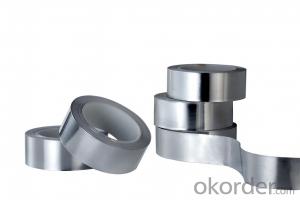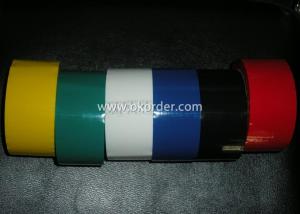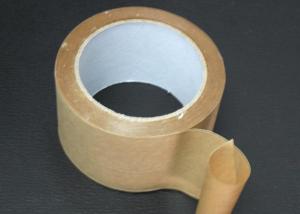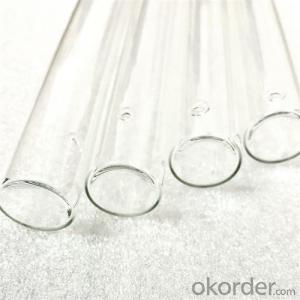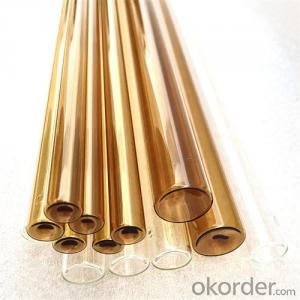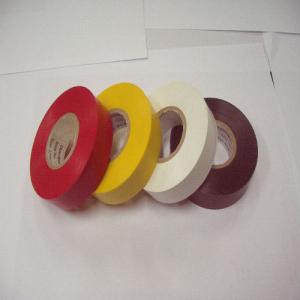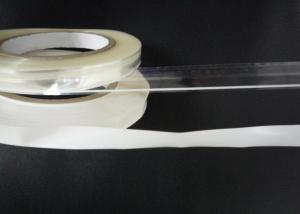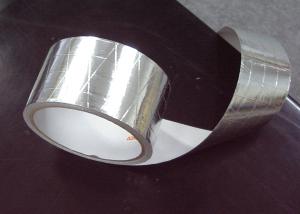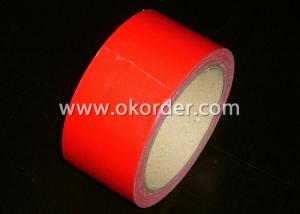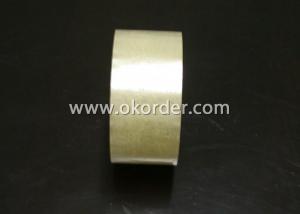PVC Wrapping Tape
OKorder Service Pledge
OKorder Financial Service
You Might Also Like
Product Description:
| ||||||||||||||||||||||||||||||||||||||||||||||||||||||||||||||
Remarks Wire Harness Tape ZFP-150
The data above are typical results and subject to change without notice.
Tolerance: Weight and Thickness: ±10%; Width: ±3mm;
Length: Cut Roll & Log Roll ±0.3m, Jumbo Roll ±0.5%.
The products should be stored at room temperature and be kept away wet and/or heat source.
It is essential, as with all pressure-sensitive tapes, that the surface to which the tape is applied must be clean, dry, and free of grease and oil.
The users should take test and do trial-application on the above products before coming into application so as to witness and ensure suitability for their special purpose and technique.
- Q:Is packaging tape easy to remove without damaging surfaces?
- Packaging tape is generally designed to be easily removable without causing damage to surfaces. However, the ease of removal can vary depending on several factors such as the type and quality of the tape, the surface it is applied to, and the length of time it has been in place. Most packaging tapes are designed to adhere firmly to surfaces during transit or storage, ensuring that the package remains sealed and secure. However, they are also designed to be peeled off easily when needed, without leaving behind residue or causing damage. In most cases, packaging tape can be removed by simply peeling it off slowly and evenly. The adhesive used in packaging tapes is typically formulated to have a good balance between adhesion and removability. This allows for easy removal without requiring excessive force or leaving behind sticky residue. However, there can be instances where the tape may be more difficult to remove, especially if it has been in place for an extended period or exposed to extreme temperature conditions. In such cases, it may be helpful to use heat (such as a hairdryer) to soften the adhesive, making it easier to peel off. It is worth noting that the ease of tape removal can also depend on the surface it is applied to. Smooth, non-porous surfaces like glass or metal are generally easier to clean without any damage. On the other hand, porous or delicate surfaces like wood or painted walls may require more caution and care during removal to avoid any potential damage. In conclusion, while packaging tape is generally easy to remove without damaging surfaces, it is important to consider factors such as tape quality, surface type, and removal technique to ensure a smooth and damage-free removal process.
- Q:What are the benefits of using tear-resistant packaging tape?
- There are several benefits of using tear-resistant packaging tape. Firstly, tear-resistant packaging tape provides enhanced security and protection to your packages during transit or storage. Its strong adhesive and tear-resistant material ensure that the tape remains intact and prevents any tampering or accidental tearing of the packaging. This helps to maintain the integrity of the contents and minimizes the risk of damage or loss. Secondly, tear-resistant packaging tape offers greater durability and longevity compared to regular packaging tapes. Its robust design and resistance to tearing make it ideal for packaging items that are heavy, have sharp edges, or are susceptible to rough handling. This ensures that the tape stays intact throughout the entire shipping process, reducing the need for re-taping or potential damage to the package. Additionally, tear-resistant packaging tape is often weather-resistant and can withstand various environmental conditions. It is designed to resist moisture, extreme temperatures, and UV exposure, making it suitable for long-distance shipping or storage in different climates. This prevents the tape from deteriorating or becoming weak, ensuring that your packages remain securely sealed and protected. Moreover, tear-resistant packaging tape is easy to use and provides a professional finish to your packages. Its strong adhesive enables it to bond quickly and securely to various surfaces, including cardboard, plastic, or metal. This ensures that the tape stays in place and does not unravel or loosen during transit. Furthermore, tear-resistant packaging tape is available in different sizes and colors, allowing you to customize your packaging and create a visually appealing presentation for your customers. In summary, the benefits of using tear-resistant packaging tape include enhanced security, increased durability, weather resistance, ease of use, and a professional appearance. By investing in tear-resistant packaging tape, you can ensure that your packages are well-protected, reduce the risk of damage or tampering, and enhance the overall shipping experience for both you and your customers.
- Q:Can packaging tape be used for sealing electronics or appliances?
- Packaging tape is not recommended for sealing electronics or appliances. While packaging tape is designed to securely seal cardboard boxes and packages, it is not suitable for sealing electronics or appliances due to various reasons. Firstly, packaging tape does not provide adequate protection against moisture or dust, which can be harmful to electronic components. Electronics and appliances require airtight sealing to prevent any damage or corrosion caused by moisture or dust particles. Secondly, packaging tape is not designed to withstand high temperatures or extreme conditions that electronics or appliances may be subject to during storage or transportation. The adhesive used in packaging tape may not be able to withstand heat or cold, which could lead to the tape peeling off and leaving the item unprotected. Thirdly, electronics and appliances often have delicate surfaces that can be easily scratched or damaged by the adhesive on packaging tape. The sticky residue left behind by the tape can also be difficult to remove from sensitive surfaces. Therefore, it is advisable to use appropriate sealing methods and materials specifically designed for electronics or appliances. These may include specialized tapes, foam gaskets, or custom-fitted protective covers. It is always recommended to consult the manufacturer's guidelines or seek professional advice when sealing electronics or appliances to ensure proper protection and functionality.
- Q:How do you distinguish between TPU tape and PVC tape?
- Also, TPU is better than PVC, and the price is much higher than PVC
- Q:Can packaging tape be used for sealing plastic bottles?
- Indeed, the utilization of packaging tape in sealing plastic bottles is possible. Designed with the purpose of providing a secure and tight seal on various surfaces, including plastic, packaging tape boasts robust adhesion. Consequently, it effectively ensures the security and protection of the bottle's contents. Nevertheless, it is crucial to acknowledge that packaging tape may not match the efficacy of specialized bottle sealing alternatives like bottle caps or seals. These alternatives are exclusively crafted for plastic bottles and offer a more dependable and leak-proof seal. Consequently, although packaging tape can serve as a temporary solution, it is advisable to employ proper bottle sealing options for the long-term storage or transportation of liquids.
- Q:Can packaging tape be used for sealing glass or delicate items?
- Yes, packaging tape can be used for sealing glass or delicate items. However, it is important to use caution and choose the appropriate tape for the job. When sealing glass or delicate items, it is recommended to use a tape that is specifically designed for these materials. Clear or transparent packaging tape is often a good option as it provides a secure seal without obstructing the view of the item. Additionally, it is important to apply the tape carefully and evenly to avoid any damage to the fragile surface. Overall, while packaging tape can be used for sealing glass or delicate items, it is crucial to select the right type of tape and apply it with caution to ensure the safety of the items being sealed.
- Q:What are the colors of the cloth?
- If it is sa too special color may not have.
- Q:Can packaging tape be used for sealing glass bottles?
- Yes, packaging tape can be used for sealing glass bottles. However, it is important to note that packaging tape is not designed specifically for sealing glass bottles, so it may not provide the same level of durability and air-tightness as specialized bottle sealing methods. Additionally, the adhesive on packaging tape may not adhere well to glass surfaces, leading to potential leakage or breakage. It is recommended to use proper bottle sealing methods such as cork stoppers, screw caps, or specialized bottle sealing tapes for glass bottles to ensure the best results.
- Q:Does packaging tape come in different materials for specific applications?
- Yes, packaging tape does come in different materials for specific applications. These materials include polypropylene, PVC, paper, and filament tape. Each material has unique properties that make it suitable for various purposes such as sealing lightweight packages, securing heavy boxes, or providing extra strength and tear resistance.
- Q:What's the maximum temperature of plastic tape?
- They are all used at 180 degrees Celsius, her limit is 260 degrees Celsius, and the production temperature should be 370 degrees celsius!
1. Manufacturer Overview |
|
|---|---|
| Location | |
| Year Established | |
| Annual Output Value | |
| Main Markets | |
| Company Certifications | |
2. Manufacturer Certificates |
|
|---|---|
| a) Certification Name | |
| Range | |
| Reference | |
| Validity Period | |
3. Manufacturer Capability |
|
|---|---|
| a)Trade Capacity | |
| Nearest Port | |
| Export Percentage | |
| No.of Employees in Trade Department | |
| Language Spoken: | |
| b)Factory Information | |
| Factory Size: | |
| No. of Production Lines | |
| Contract Manufacturing | |
| Product Price Range | |
Send your message to us
PVC Wrapping Tape
OKorder Service Pledge
OKorder Financial Service
Similar products
New products
Hot products
Hot Searches
